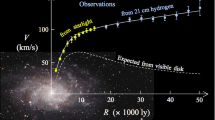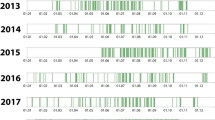Abstract
IT has been suggested1 that black holes of mass ≤1015 g evaporate in ∼1010 yr, ultimately annihilating into a burst of energetic photons and particles. This explosion would produce γ-rays directly, and a radio pulse with a characteristic frequency of ∼3 GHz and an energy of ∼1032 erg may also be generated2. It has been shown2–4 that such a radio burst would be far more easily detected than the corresponding γ-ray burst. Estimates of the energy in the radio burst are uncertain by many orders of magnitude, and it is, of course, not known whether any primordial black holes exist at all; however, the implications of a detection would be enormous for quantum and gravitational physics.
Similar content being viewed by others
References
Hawking, S. W. Nature 248, 30–31 (1974).
Rees, M. J. Nature 266, 333–334 (1977).
Jelley, J. V., Baird, G. A. & O'Mongain, E. Nature 267, 499–500 (1977).
Meikle, W. P. S. Nature 269, 41–42 (1977).
Readhead, A. C. S. & Duffett-Smith, P. J. Astr. Astrophys. 42, 151–153 (1975).
Author information
Authors and Affiliations
Rights and permissions
About this article
Cite this article
O'SULLIVAN, J., EKERS, R. & SHAVER, P. Limits on cosmic radio bursts with microsecond time scales. Nature 276, 590–591 (1978). https://doi.org/10.1038/276590a0
Received:
Accepted:
Issue Date:
DOI: https://doi.org/10.1038/276590a0
- Springer Nature Limited





